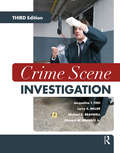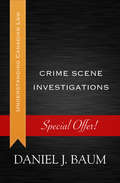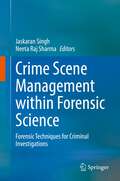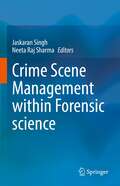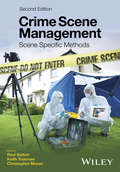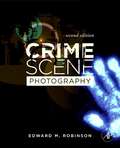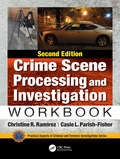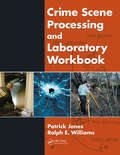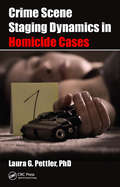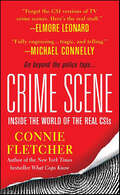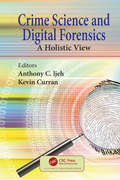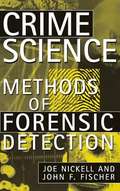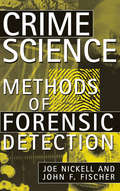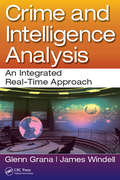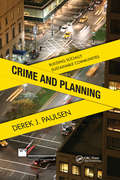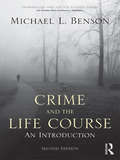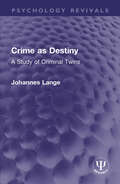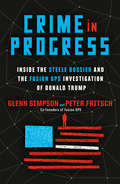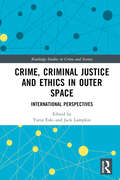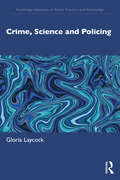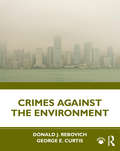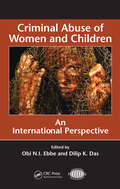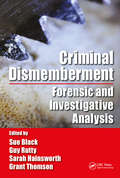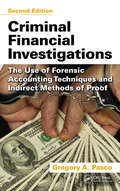- Table View
- List View
Crime Scene Investigation: Step By Step From The Crime Scene To The Courtroom
by Larry S. Miller Michael C. Braswell Jacqueline T. Fish Edward W. WallaceCrime Scene Investigation offers an innovative approach to learning about crime scene investigation, taking the reader from the first response on the crime scene to documenting crime scene evidence and preparing evidence for courtroom presentation. It includes topics not normally covered in other texts, such as forensic anthropology and pathology, arson and explosives, and the electronic crime scene. Numerous photographs and illustrations complement text material, and a chapter-by-chapter fictional narrative also provides the reader with a qualitative dimension of the crime scene experience.
Crime Scene Investigations
by Daniel J. BaumWhen police are called in to investigate a crime, what powers and limitations apply to them? What are their rights to question strangers, search without warrants, or detain individuals who might become suspects? Crime Scene Investigations breaks down the Supreme Court's decisions on questions like these into clear and practical terms. Police need to be vigilant, since the line between a lawful search and an improper one can be dangerously thin, and officers can be held accountable for any wrongdoing, intentional or not. The controversy surrounding such techniques as "stop-and-frisk" sweeps and compulsory DNA testing underscores the importance of understanding the legal dimensions of police powers. Because interactions between law enforcement officers and civilians are often charged with complexities, Crime Scene Investigations provides a level-headed guide, indispensable for those on either side of an investigation.
Crime Scene Management within Forensic Science: Forensic Techniques for Criminal Investigations
by Neeta Raj Sharma Jaskaran SinghThis book, the second volume of Crime Scene Management in Forensic Sciences, reviews the role and impact of forensic evidence in criminal investigations. It also addresses the importance of post mortem examination in criminal cases. The book investigates the use of insects and arthropods to estimate post mortem intervals during forensic investigations. Further, it discusses the physiological effects of xenobiotics at the time of death, based on their concentration and distribution in the body at autopsy. Importantly, it also discusses digital forensic investigation, which can be used for the analysis of digital evidence produced at a court of law. Lastly, it defines the structure and legal framework of these forensic evidences for the effective administration of the criminal justice system. It is an excellent source of information for forensics scientists and legal professionals.
Crime Scene Management within Forensic science
by Neeta Raj Sharma Jaskaran SinghThis book provides deep insight into the significance of various forensic techniques underlying the methodical approaches in criminal investigations. The book comprises numerous case studies, examples, and reference materials. It emphasizes on the better practices for criminal investigations including contemporary examinations. The book also describes various methods for investigation of crime scene and evidence collection including biological evidences to the resources of law enforcement agencies. This book encompasses the procedure for crime scene-documentation through photography, video, and diagrams and highlights the best practices of packaging the biological evidences at a crime scene. Further, it summarizes the role of forensic autopsy to the criminal investigation system. As such, the book is helpful for forensic scientists, medical practitioners, educators and law enforcement personnel.
Crime Scene Management: Scene Specific Methods
by Christopher Moran Keith Trueman Raul SuttonSecond edition of an established text on common procedures for the identification and processing of evidence at scenes of crime Includes chapters on quality assurance and credibility of practices and processes issues surrounding major and complex crime Forensic handling of mass fatalities Crime scene reconstruction and impact on evidence recovery processes
Crime Scene Management: Scene Specific Methods
by Christopher Moran Keith Trueman Raul SuttonSecond edition of an established text on common procedures for the identification and processing of evidence at scenes of crime Includes chapters on quality assurance and credibility of practices and processes issues surrounding major and complex crime Forensic handling of mass fatalities Crime scene reconstruction and impact on evidence recovery processes
Crime Scene Photography (Second Edition)
by Edward M. RobinsonCrime Scene Photography, Second Edition covers the general principals and concepts of photography, while also delving into the more practical elements and advanced concepts of forensic photography. Edward Robinson assists the reader in understanding and applying essential concepts in order to create images that are able to withstand challenges in court. The first part of the book deals with the basic theory and science of photography required to take superior photographs, and covers topics such as composition, exposure, focus, depth of field, and flash techniques. The second part of the text deals specifically with the challenges of photographing a crime scene, including instructions on how to document bodies and wounds, traffic accident photography, underwater photography and aerial photography. In the latter portions of the text, the author turns to digital theory and its advantages and disadvantages. * Over 600 full color photographs, also electronically available on the companion website * Two new chapters on 'The History of Forensic Photography,' and 'Digital Image Processing of Evidentiary Photography' * Includes an Instructor website with lecture slides, practical exercises, a test bank and image collection * An essential reference for crime scene photography, including topics such as Composition, the Inverse Square Law, Court Cases affecting photography, Digital Image Processing, and Photogrammetry * Required reading by the Crime Scene Certification Board of the International Association for Identification (IAI) for all levels of certification
Crime Scene Processing and Investigation Workbook, Second Edition
by Christine R. Ramirez Casie L. Parish-FisherCrime Scene Processing and Investigation Workbook, Second Edition is the only workbook which directly supports and cross-references methodology and terminology presented in Ross Gardner and Donna Krouskup’s perennial best-seller Practical Crime Scene Processing and Investigations, Third Edition. The workbook serves as supporting material offering hands-on activities to supplement theories and methodologies within the text as well as updated activities to support the new material presented in the Third Edition. As the number of forensic academic programs within the United States continue to grow—and the textbook continues to be a go-to standard in the field—the workbook remains an invaluable reference for academics, forensic training providers, and law enforcement training programs. The detailed Instructor’s Manual (IM) lends itself not only to experts who have utilized these procedures before but also to the novice and student who may be introduced to these topics in a classroom setting for the first time. The workbook conducts over 30 activities with detailed instructions, concept overviews, and reflective post-lab questions. Crime Scene Processing and Investigation Workbook, Second Edition, continues to stand as the best workbook on the market, addressing foundational principles in a hands-on manner while directly correlating to the concepts addressed in the Gardner and Krouskup textbook.
Crime Scene Processing and Laboratory Workbook
by Patrick Jones Ralph E. WilliamsThe most important part of a CSI‘s (crime scene investigator) job is accurate documentation of properly collected evidence. Documentation tells the story of the crime and can ultimately prove a suspect guilty. Through an array of specific exercises and actual document templates used in practice, Crime Scene Processing and Laboratory Workbook teache
Crime Scene Staging Dynamics in Homicide Cases
by Laura Gail PettlerIndividuals who perpetrate murder sometimes pose or reposition victims, weapons, and evidence to make it look like events happened in a different way than what actually transpired. Until now, there has been scarce literature published on crime scene staging.Crime Scene Staging Dynamics in Homicide Cases is the first book to look at this practice, p
Crime Scene: Inside the World of the Real CSIs
by Connie FletcherMost people who work as actual crime scene investigators will tell you two things: Television doesn't always show the truth...and science never lies. But how do DNA experts, trace analysts, medical examiners, forensic pathologists, and cold case detectives work together to produce evidence and solve a case—beyond the shadow of a doubt? In this fascinating, true-life account, America's leading crime experts share their personal, unforgettable stories. From powder burn to fiber analysis, blood spatter to skeletal remains, New York Times bestselling author Connie Fletcher takes you into a world of crime-solving that's even grittier, more bizarre, and more shocking than any TV show. It's a thrilling ride into the dead center of a crime scene.
Crime Science and Digital Forensics: A Holistic View
by Anthony C. IjehThis volume is a collation of articles on counter forensics practices and digital investigative methods from the perspective of crime science. The book also shares alternative dialogue on information security techniques used to protect data from unauthorised access and manipulation. Scandals such as those at OPCW and Gatwick Airport have reinforced the importance of crime science and the need to take proactive measures rather than a wait and see approach currently used by many organisations. This book proposes a new approach in dealing with cybercrime and unsociable behavior involving remote technologies using a combination of evidence-based disciplines in order to enhance cybersecurity and authorised controls. It starts by providing a rationale for combining selected disciplines to enhance cybersecurity by discussing relevant theories and highlighting the features that strengthen privacy when mixed. The essence of a holistic model is brought about by the challenge facing digital forensic professionals within environments where tested investigative practices are unable to provide satisfactory evidence and security. This book will be of interest to students, digital forensic and cyber security practitioners and policy makers. It marks a new route in the study of combined disciplines to tackle cybercrime using digital investigations and crime science.
Crime Science: Methods of Crime Detection
by Joe Nickell John F. FischThis method is empirical (from the Latin empiricus, "experienced"), meaning that knowledge is gained from direct observation.
Crime Science: Methods of Forensic Detection
by Joe Nickell John F. FischerThis comprehensive guide to forensic investigation &“delivers the goods for the educated layperson . . . readers will be hard-pressed to put it down&” (USA Today). Forensic experts Joe Nickell and John Fischer introduce readers to the work of firearms experts, document examiners, fingerprint technicians, medical examiners, and forensic anthropologists. These topics are explained in clear terms without technical jargon. Nickell and Fisher describe fingerprint classification and autopsies, explain how fibers link victims to their killers, and examine the science underlying DNA profiling and toxicological analysis. From weapons analysis to handwriting samples to shoe and tire impressions, Crime Science outlines the indispensable tools and techniques that investigators use to make sense of a crime scene. Each chapter closes with a study of an infamous case to demonstrate how the principles of forensic science work in practice. Case studies including the O.J. Simpson trial, the Lindbergh kidnapping, the death of Marilyn Monroe, the World Trade Center bombing, the assassination of the Romanovs, and the Atlanta child murders.
Crime and Intelligence Analysis: An Integrated Real-Time Approach
by James Windell Glenn GranaCrime and Intelligence Analysis: An Integrated Real-Time Approach covers everything crime analysts and tactical analysts need to know to be successful. Providing an overview of the criminal justice system as well as the more fundamental areas of crime analysis, the book will enable students and law enforcement personnel to better understand criminal behavior, learn the basics of conducting temporal analysis of crime patterns, use spatial analysis to better understand crime, apply research methods to crime analysis, and more successfully evaluate data and information to help predict criminal offending and solve criminal cases. Criminal justice and police academy students will learn how to be skilled and credible crime analysts who play a critical role in the daily operations of law enforcement.
Crime and Planning: Building Socially Sustainable Communities
by Ph.D., Derek PaulsenThe form and layout of a built environment has a significant influence on crime by creating opportunities for it and, in turn, shaping community crime patterns. Effective urban planners and designers will consider crime when making planning and design decisions. A co-publication with the American Planning Association, Crime and Planning:
Crime and the Life Course
by Michael BensonIn recent years, the lifecourse perspective has become a popular theoretical orientation toward crime. Yet despite its growing importance in the field of criminology, most textbooks give it only cursory treatment. Crime and the Lifecourse: An Introduction by Michael L. Benson provides a comprehensive overview of contemporary research and theory on the life-course approach to crime. The book emphasizes a conceptual understanding of this approach. A special feature is the integration of qualitative and quantitative research on criminal life histories. This book: provides an overview of the life course approach and describes the major concepts and issues in lifecourse theory as it applies to criminology reviews evidence on biological and genetic influences on crime reviews research on the role of the family in crime and juvenile delinquency provides a detailed discussion of the criminological lifecourse theories of Moffitt, Hagan, Sampson and Laub, and others discusses the connections between youthful crime and adult outcomes in education, occupation, and marriage presents an application of the lifecourse approach to white-collar crime discusses how macro sociological and historical developments have influenced the shape of the lifecourse in American society as it relates to patterns in crime.
Crime as Destiny: A Study of Criminal Twins (Psychology Revivals)
by Johannes LangeFirst published in 1931, Crime as Destiny throws a beam of light across the darkness which enshrouds the study of the deeper causes of crime and the eternal debate between nature versus nurture. The author’s investigations led him to conclusions of the first importance to the sociologist and the psychologist. But the subject is wilder than it seems and by its direct bearing on the question of determinism will arouse the interest of the theologian and the student of philosophy as well. For the student of history, this research work will help trace the beginning of the logic of eugenics that will eventually take its nightmarish form under Hitler.
Crime in Progress: Inside the Steele Dossier and the Fusion GPS Investigation of Donald Trump
by Peter Fritsch Glenn SimpsonBefore Ukraine, before impeachment: This is the never-before-told inside story of the high-stakes, four-year-long investigation into Donald Trump’s Russia ties—culminating in the Steele dossier, and sparking the Mueller report—from the founders of political opposition research company Fusion GPS. <P><P>“Crime in Progress untangles one of the great mysteries of the Trump era—the full story of the Steele dossier—and provides a fascinating insight into the investigatory mind at work.”—Jeffrey ToobinFusion GPS was founded in 2010 by Glenn Simpson and Peter Fritsch, two former reporters at The Wall Street Journal who decided to abandon the struggling news business and use their reporting skills to conduct open-source investigations for businesses and law firms—and opposition research for political candidates. In the fall of 2015, they were hired to look into the finances of Donald Trump. <P><P>What began as a march through a mind-boggling trove of lawsuits, bankruptcies, and sketchy overseas projects soon took a darker turn: The deeper Fusion dug, the more it began to notice names that Simpson and Fritsch had come across during their days covering Russian corruption—and the clearer it became that the focus of Fusion&’s research going forward would be Trump’s entanglements with Russia.To help them make sense of what they were seeing, Simpson and Fritsch engaged the services of a former British intelligence agent and Russia expert named Christopher Steele. <P><P>He would produce a series of memos—which collectively became known as the Steele dossier—that raised deeply alarming questions about the nature of Trump&’s ties to a hostile foreign power. Those memos made their way to U.S. intelligence agencies, and then to President Barack Obama and President-elect Trump. <P><P>On January 10, 2017, the Steele dossier broke into public view, and the Trump-Russia story reached escape velocity. At the time, Fusion GPS was just a ten-person consulting firm tucked away above a Starbucks near Dupont Circle, but it would soon be thrust into the center of the biggest news story on the planet—a story that would lead to accusations of witch hunts, a relentless campaign of persecution by congressional Republicans, bizarre conspiracy theories, lawsuits by Russian oligarchs, and the Mueller report.In Crime in Progress, Simpson and Fritsch tell their story for the first time—a tale of the high-stakes pursuit of one of the biggest, most important stories of our time—no matter the costs. <P><P><b> A New York Times Bestseller </b>
Crime, Criminal Justice and Ethics in Outer Space: International Perspectives (Routledge Studies in Crime and Society)
by Yarin EskiBreaking new ground in criminology, this book reflects on the expansion of outer space endeavours, the new pathways this presents for crime, challenges to Earth-based conceptions of justice, and the ethical issues raised.This book is the first edited collection of chapters focused on how to prepare for, address and respond to, instances of criminal and harmful behaviour in (and related to) outer space. It also considers what criminal justice might look like in outer space, and how the important arena of ethics might play a pivotal role in helping overcome problems related to crime and crime control. The book comprises 24 chapters from authors spanning six continents, giving a truly international dimension to the first anthology relating to the intersection of space criminology, space criminal justice and space ethics. It is this international dimension that is essential to the development of a holistic understanding of crime, criminal justice and ethics in outer space.Exploring recent topics, including the dark origin of space exploration, expansion of satellite industries, space tourism, asteroid mining and human settlement on the Moon and Mars, the book will appeal to space professionals, and students and researchers working in criminology, critical security studies, law, and ethics.
Crime, Science and Policing
by Gloria LaycockThis book offers an introduction to crime science; it is specifically for police and security professionals. Written by one of the founders of crime science and an expert in crime reduction, it considers the unique characteristics of the approach, its applicability to the control of crime, disorder and terrorism, and the importance of experimentation and the testing of new ideas to build a knowledge base for ethical policing. Core content includes: The basics of crime science in concept, theory and practice; Methods of research and assessment used by crime scientists; Crime science and policing, including its application to volume crimes, serious crimes and investigation; Legitimacy and public compliance; Policing, science, and future crimes. This book is essential reading for all students of professional policing, as well as those interested in crime and its control, reduction, and prevention.
Crimes Against the Environment
by Donald J. Rebovich George E. CurtisCrimes Against the Environment explains the seriousness of the threat posed by pollution, its roots, how it has evolved, how it differs across the planet, and how society has endeavored to create and enforce laws directed at its control. Rebovich and Curtis begin with an overview of hazardous waste, the industries that produce toxins, available methods of waste treatment, and the legal environment of environmental crime. They examine the forces driving criminal behavior and the methods offenders adopt, as well as protections against polluters and their effectiveness. The book concludes with an examination of environmental justice in the United States and globally, and looks ahead to the future of crime control and prevention in this arena. Case studies and discussion questions offer further perspective on these challenging issues of environmental integrity. This text serves undergraduate or early-stage graduate students majoring in criminal justice, environmental science, sociology, and political science, and could also serve as a resource for professionals in environment-related occupations.
Criminal Abuse of Women and Children: An International Perspective (International Police Executive Symposium Co-Publications)
by Dilip K. Das Obi N.I. EbbeThe abuse of women and children transcends geographical boundaries as well as economic, cultural, religious, political, and social divisions. Comprised of the work of more than 20 academics and practitioners from around the world, Criminal Abuse of Women and Children documents the atrocities that have been committed against these victims from ancie
Criminal Dismemberment: Forensic and Investigative Analysis
by Sue Black Guy Rutty Sarah V. Hainsworth Grant ThomsonCriminal Dismemberment is the first book to examine dismemberment as a phenomenon in the context of criminal acts. While the number of such dismemberment cases in any given country is often small, the notion of dismemberment captures the imagination, often leading many to question the motivations as to why anyone would perpetrate such an unnatural act. The act of dismemberment, in its original form, referred to cutting, tearing, pulling, wrenching or otherwise separating the limbs from a living being as a form a capital punishment. In today’s society, it has become associated most frequently with the criminal act of sectioning the remains of the dead in an attempt to conceal the death and dispose of the remains or make the process of identification of the deceased more difficult to achieve. Drawing on expertise from leading forensic anthropologists, pathologists, and forensic materials engineers, the book brings together much of the literature on criminal dismemberment—viewing it from the investigative, forensic, and social science perspectives. Key features include: Psychological analysis of the perpetrator Detailed examination of case studies, anonymized from recent investigations Difficulties encountered in a dismemberment investigation Tool mark analysis, including knives and saws, accompanied by over 120 detailed, full-color illustrations and photographs Serves as a unique and useful resource in the investigation of dismembered human remains The diverse backgrounds of the contributors offers a thorough account of such topics as the history of dismemberment, the forensic pathology in such cases, the importance of developing a common vocabulary in terminology used, the legal admissibility in dismemberment cases. As such, Criminal Dismemberment will serve as a comprehensive reference for students and practitioners alike.
Criminal Financial Investigations: The Use of Forensic Accounting Techniques and Indirect Methods of Proof, Second Edition
by Dale L. June Gregory A. PascoUnderstanding the financial motivations behind white collar crime is often the key to the apprehension and successful prosecution of these individuals. Now in its second edition, this volume provides direct instruction on the how to aspects of criminal financial investigations, taking readers through the different approaches used in gathering evidence and demonstrating how to present circumstantial evidence to a judge or jury in a simple and convincing manner. Written by a former Special Agent with the Criminal Investigation Division of the U.S. Internal Revenue Service, the book sets out a methodology enabling readers to identify, pursue, and successfully prosecute white collar crime.
